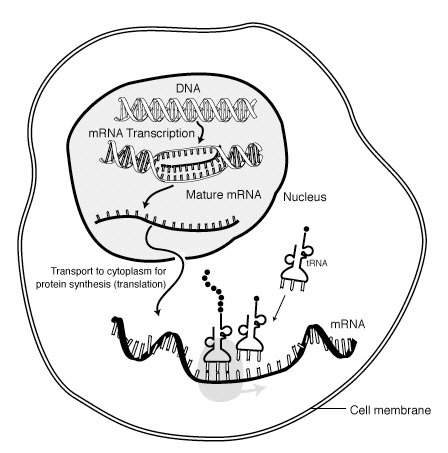Biology Forum › Molecular Biology › What does mRNA do in protein synthesis?
- AuthorPosts
- August 3, 2021 at 5:41 am #118414
 Nadine OmarParticipant
Nadine OmarParticipantHi everyone! Let’s find out the role of mRNA in protein synthesis and more with FAQ.
What is the role of mRNA in protein synthesis?
What does mRNA do? messenger RNA uses the genetic code to make proteins that perform different functions in the body or its cells.
Do you know which proteins are synthesized in the body? Proteins function as enzymes and hormones. Comment below on other protein functions.
Protein synthesis is mediated by a single-stranded mRNA.
FAQ
Here’s a list of answers to the most common questions about mRNA!
Question: What is mRNA?
Answer: It is a single-stranded RNA molecule that is formed in the nucleus as a complementary strand to one of the DNA strands. mRNA is a copy of genes in the form of RNA that leaves the nucleus to the cytoplasm.Question: Where is mRNA synthesized?
Answer: mRNA is synthesized in the nucleus of the cell where DNA is located. RNA processing leads to the formation of mRNA. It carries the genetic code from the nucleus of the cell to ribosomes in the cytoplasm where protein is synthesized. Ribosomes act as machinery in the cell for synthesizing proteins, they are complex large structures made up of proteins and ribosomal RNA.Question: What does mRNA stand for?
Answer: mRNA stands for messenger ribonucleic acid.Question: How does mRNA work?
Answer: Ribosomes in the cytoplasm move along the mRNA reading the sequence of bases on mRNA in the form of coons or triplets, the triplets are then translated into the corresponding amino acids resulting in the formation of a certain protein.The sequence of DNA nucleotides in the nucleus is used as a template to synthesize mRNA. DNA to mRNA synthesis is catalyzed by RNA polymerase II enzymes. Do you know the name of this process?
- Translation
- Transcription
- Polymerization
- Replication
mRNA strand acts as a guide for the synthesis of proteins in ribosomes. It guides the process of protein synthesis by carrying messages to the cytoplasm. mRNA sequence of nucleotides encodes messages which are complementary for the sequence of nucleotides on the DNA that serves as a template for mRNA synthesis.
Proteins are then created in a sequence of DNA to RNA to protein by ribosomes in a process known as the translation where ribosomes translate messages from mRNA to synthesize the protein step by step.
But how does the sequence of amino acids is specified on mRNA to synthesize a protein?
proteins are made up of amino acids. Each amino acid is specified by a sequence of three nucleotides on mRNA called a codon. Each coon represents an amino acid to be incorporated into the protein. However, codons of mRNA do not specify and recognize amino acids directly; but they use another type of RNA which is tRNA to recognize codons of mRNA and specify the corresponding amino acids to these codons. tRNA contains anticodons; which are complementary to codons on mRNA.
Question: What is the genetic code?
Answer: The genetic code is the system that combines different components of protein synthesis such as the sequence of nucleotides on the DNA, mRNA, tRNA, and their interaction together.
mRNA function does not include synthesizing proteins; however, it is essential in the process of protein synthesis as it carries messages from DNA to the site of action where tRNA converts the information carried by the mRNA to amino acids sequence (Feher, 2017).

Fig 1: Protein synthesis diagramLearn more about protein synthesis here:: https://www.biologyonline.com/dictionary/protein-synthesis
Question: What happens during the synthesis of mRNA?
Answer: The formed mRNA is complementary to one strand of the original DNA. It is formed when the DNA strand is unwound and separated into two strands.In your opinion, why do DNA strands not move out of the nucleus to be used as a template for protein synthesis in ribosomes?
DNA strands are too large so they cannot leave the nucleus, moreover, preserving the DNA as a source of genetic material is important. Therefore, mRNA is used as a messenger to transfer the nucleotide sequence used for making a certain protein from DNA in the nucleus to ribosomes in the cytoplasm. Each mRNA molecule carries codons for one protein only.
mRNA technology uses mRNA code sequences to induce the production of a specific mRNA protein inside the human body to fight different diseases.
Comment below if you want to know more about mRNA technology or your questions about mRNA! Let’s discuss!
- AuthorPosts
You must be logged in to reply to this topic.
